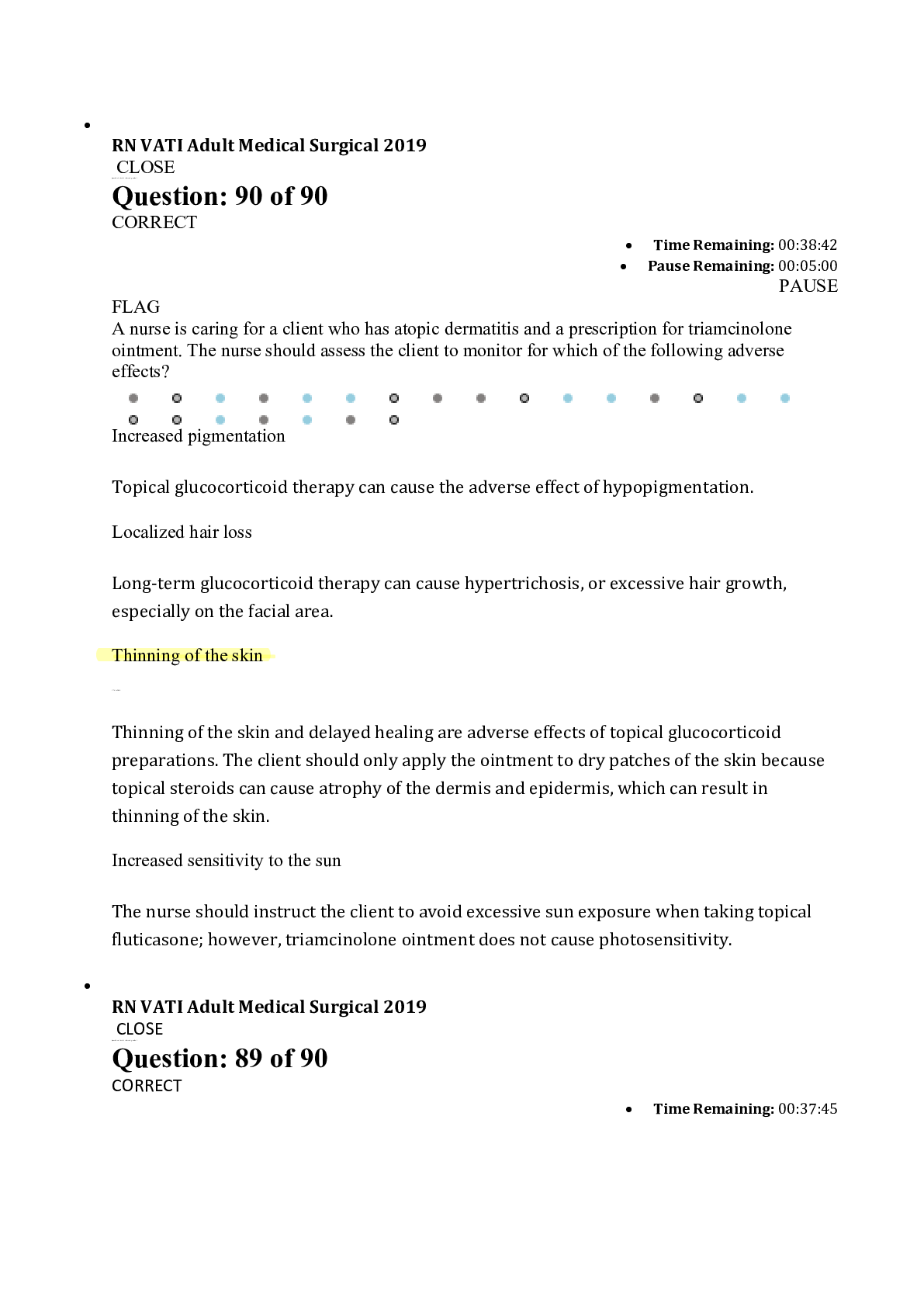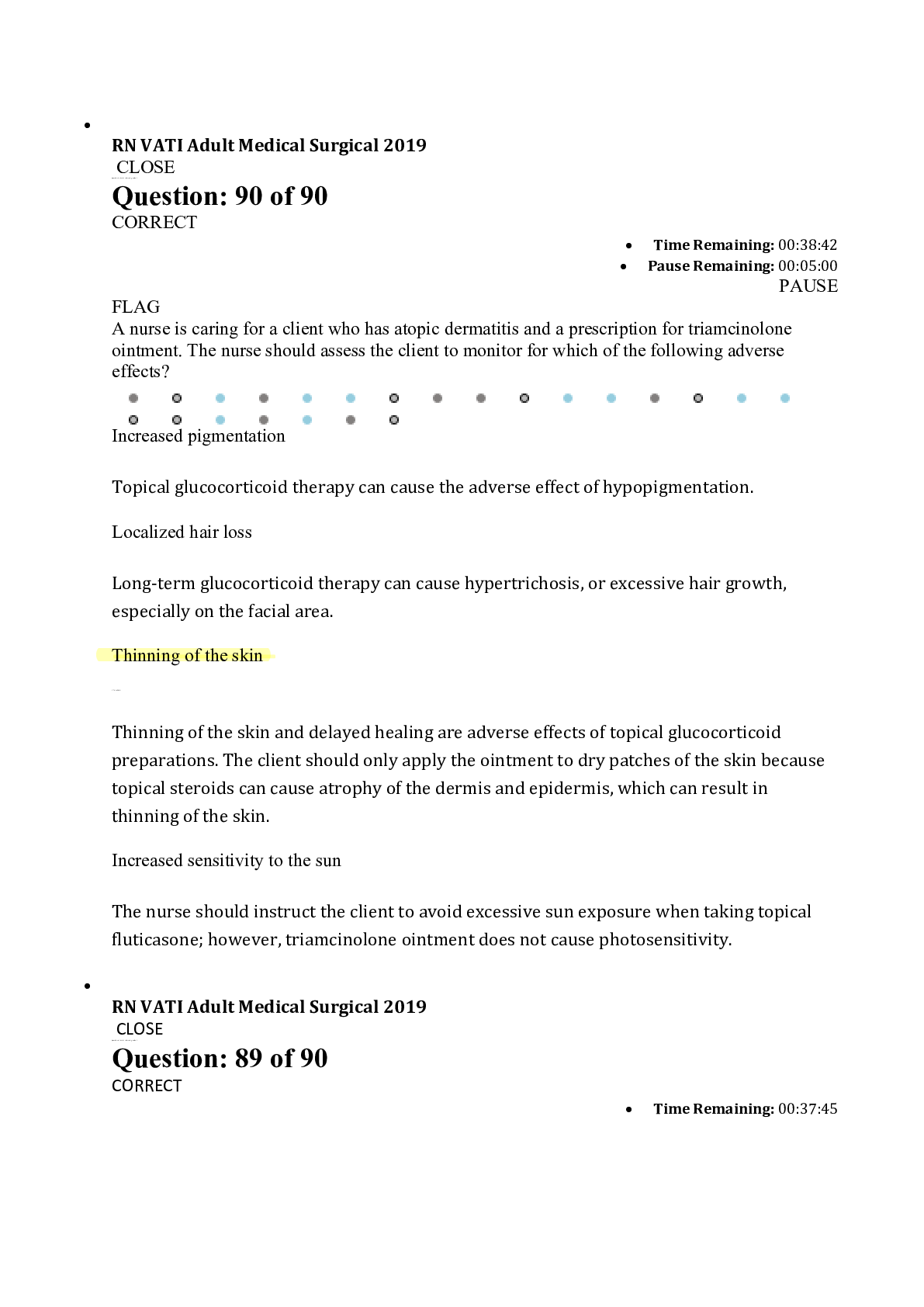FLAG
A nurse is caring for a client who has atopic dermatitis and a prescription for triamcinolone ointment. The nurse should assess the client to monitor for which of the following adverse effects?
Increased pigmentation
Topical glucocorticoid therapy can cause the adverse effect of hypopigmentation.
Localized hair loss
Thinning of the skin
MY ANSWER
Increased sensitivity to the sun
Long-term glucocorticoid therapy can cause hypertrichosis, or excessive hair growth,
especially on the facial area.
Thinning of the skin and delayed healing are adverse effects of topical glucocorticoid
preparations. The client should only apply the ointment to dry patches of the skin because
topical steroids can cause atrophy of the dermis and epidermis, which can result in
thinning of the skin.
The nurse should instruct the client to avoid excessive sun exposure when taking topical
fluticasone; however, triamcinolone ointment does not cause photosensitivity.
•
CLOSE
Question: 89 of 90
CORRECT
RN VATI Adult Medical Surgical 2019
Question 89 loaded rationals provided
• Time Remaining: 00:37:45
Downloaded by: kiaritalaboy |
[email protected] Distribution of this document is illegal
Stuvia.com - The Marketplace to Buy and Sell your Study Material
• Pause Remaining: 00:05:00 PAUSE
FLAG
A nurse is assessing a client who has left-sided heart failure. Which of the following findings should the nurse identify as a manifestation of left-sided heart failure?
Dependent edema
Jugular distention
Weight gain
Frothy sputum
MY ANSWER
The nurse should identify that dependent edema is a manifestation of right-sided heart
failure due to right ventricular failure and fluid retention from pressure building up in the
venous system.
The nurse should identify that jugular vein distention is a manifestation of right-sided heart
failure due to right ventricular failure and fluid retention from pressure building up in the
venous system.
The nurse should identify that weight gain is a manifestation of right-sided heart failure
due to right ventricular failure and fluid retention from pressure building up in the venous
system.
The nurse should identify that frothy sputum, dyspnea, and wheezing are manifestations of
left-sided heart failure. Treatment includes fluid restriction and diuretics to decrease
preload and reduce pulmonary congestion. Pink-tinged frothy sputum can be an early
indication of pulmonary edema and can be life-threatening. Therefore, the nurse should
notify the provider immediately.
•
CLOSE
Question: 88 of 90
CORRECT
RN VATI Adult Medical Surgical 2019
Question 88 loaded rationals provided
Downloaded by: kiaritalaboy |
[email protected] Distribution of this document is illegal
Stuvia.com - The Marketplace to Buy and Sell your Study Material
• Time Remaining: 00:37:30 • Pause Remaining: 00:05:00 PAUSE
FLAG
A nurse is caring for a client who is experiencing anxiety as well as numbness and tingling of the lips and fingers. The client's ABGs are: pH 7.48, PCO2 30 mm Hg, HCO3- 24 mEq/L, PaO2 85 mm Hg. Which of the following acid-base imbalances should the nurse identify that the client is experiencing?
Respiratory alkalosis
MY ANSWER
Respiratory acidosis
Metabolic alkalosis
Metabolic acidosis
•
CLOSE
Question: 87 of 90
CORRECT
This pH is alkaline (increased) and the PCO2 is decreased, representing alveolar
hyperventilation and resultant respiratory alkalosis.
This pH is alkaline (increased) and the PCO2 is decreased. A decreased pH and an increased
PCO2 indicate respiratory acidosis.
This HCO3- 24 mEq/L is within the expected range of 21 to 28 mEq/L and the pH is alkaline
(increased). An increased pH and HCO3- indicate metabolic alkalosis.
This HCO3- 24 mEq/L is within the expected range of 21 to 28 mEq/L and the pH is alkaline
(increased). A decreased pH and HCO3- indicate metabolic acidosis.


